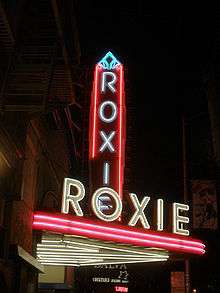Roxie Theater

The Roxie Theater is a movie theater at 3117 16th Street in the Mission District of San Francisco built in 1909. It is also known as the Roxie Cinema or just The Roxie.
History
The oldest continuously operating movie theater in San Francisco, the Roxie opened its doors as the C. H. Brown Theater in 1909, and was owned and operated as the Poppy Theater from 1912 to 1916 by Philip H. Doll, a local jeweler and watchmaker.
The 300-seat theater was renovated in 1933, changed its name to The Roxie, and added its unusual marquee with neon sign but no place for movie titles. In 2003, a 49-seat theater dubbed the Little Roxie opened two doors from the main theater.
Other names for the theater:
- The Poppy 1912-1916
- The New 16th Street 1916-1920
- The Rex 1920-1926
- The Gem 1926-1930
- The Gaiety 1930-1933
- The Roxie 1933–present
In the late 1960s with the decline of its neighborhood, The Roxie became a pornography theater. In March 1976, community leaders Robert Christopher Evans, Dick Gaikowski, Peter Moore, and Tom Mayer bought the Roxie, remodeled it, and turned it into an art and independent film center. Between November 1-15, 1979, the Roxie hosted the U.S. premiere of Luis Buñuel's L'Âge d'Or (1930), a film that had been banned for almost 50 years. Over the years, the Roxie has been home to many film festivals such as the Frameline Film Festival, the San Francisco Jewish Film Festival, the Arab Film Festival, SF Indiefest, and many others.
On December 26, 2005, the San Francisco Chronicle reported that the Roxie had agreed to be acquired by New College of California, a small liberal arts college also based in the Mission District. New College agreed to pay off the Roxie's debts and to pay salaries of Roxie employees going forward. The Roxie became part of New College's Media Studies Program on January 1, 2006, and was renamed the "Roxie Film Center at New College".
On February 26, 2008, New College announced it was closing, thus ending its support of the Roxie.[1] After New College’s collapse, New College Board member Rod Holt and his son Alan took over the theater’s lease and filed for 501(c)3 non-profit status. In 2009 the Roxie became a not-for-profit organization, committed to remaining a critical and historical center for film, culture, and contemporary practices in the direct community and beyond.
In 2010 Alan Holt transitioned from Executive Director to a seat on the Board and community activist and philanthropist Christopher Statton joined the Roxie as Executive Director and member of the Board.[2] Over his four-year tenure, Statton established the Roxie as a community-based non-profit, including the creation of the Roxie's Lights. Camera. Action! Awards to honor Bay Area social justice documentary filmmakers. The inaugural Awards honored the filmmaking team Rob Epstein and Jeffrey Friedman and filmmaker Hima B for the significant contributions these filmmakers have had in bringing attention and awareness to the challenges of those living with HIV/AIDS.[3] Statton also raised over $400,000 in contributions to help support the Roxie's programming and operations.[4] In 2013 Statton was awarded the Marlon Riggs Award by the San Francisco Film Critics Circle for “his significant contribution to San Francisco’s film community through the Roxie Theater over the past four years.”[5] In 2013, San Francisco District 9 Supervisor David Campos awarded Statton with a Certificate of Honor for his “important and tireless work with the Roxie.” Statton resigned from the Roxie in 2013 due to health concerns.
In December 2013, the Roxie announced Isabel Fondevila as the new director. Fondevila is the former Board President of Artists' Television Access. [6]
Roxie Releasing
The theatre also is home to Roxie Releasing, an independent film distributor most notably responsible for the 30th anniversary re-release of George A. Romero's Night of the Living Dead. Roxie Releasing specializes in documentaries.
References
- ↑ College's woes cloud Roxie's future
- ↑ 2013 The Most Positive of Positive People
- ↑ Roxie fundraiser fetes queer filmmakers
- ↑ Chris Statton resigns from Roxie Cinema board
- ↑ 2013 SAN FRANCISCO FILM CRITICS CIRCLE AWARDS
- ↑ G. Allen Johnson, "Roxie Theater Announces New Director", San Francisco Chronicle (December 26, 2013)
See also
External links
- Roxie Theater website
- Article on the Roxie by Roger Rose in CineSource September 4, 2008
- Facebook page
Coordinates: 37°45′53″N 122°25′21″W / 37.76472°N 122.42250°W